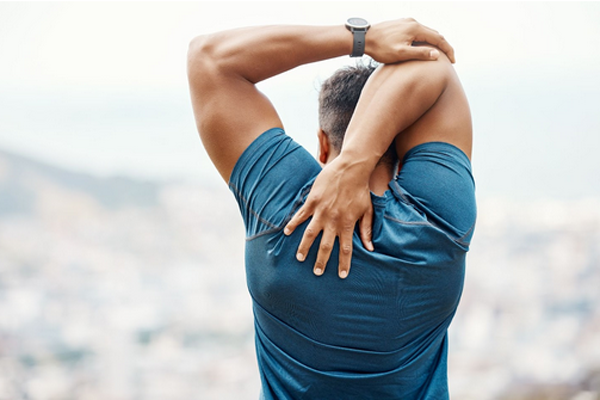Diving a little deeper into the inner workings of your shoulder joint may help you avoid future injuries, be more informed about your treatment choices and appreciate the complex design of this joint.
The Anatomy of the Shoulder
With all that the shoulder joint is capable of, it's no wonder it is one of the most complicated joints in your body. The shoulder is a "ball-and-socket" joint made up of bones, tendons, muscles and ligaments. This joint is responsible for connecting your upper arm to your torso.The Shoulder Bones
The shoulder consists of three bones: the clavicle (collarbone), the scapula (shoulder blade), and the humerus (upper arm bone). The clavicle acts as a strut connecting the sternum (breastbone) in the front of your body to the scapula in the back. The scapula is a large, flat bone that connects the humerus to the clavicle. The scapula allows for six types of movements in the shoulder:- Elevation
- Depression
- Protraction
- Retraction
- Upward rotation
- Downward rotation
The Shoulder Joints
There are three joints in the shoulder girdle, including the sternoclavicular (SC), acromioclavicular (AC) and the glenohumeral joint. The SC joint is where your clavicle meets your sternum in the front of your chest. The movement of the SC joint is restricted by the tight ligaments surrounding it. However, this joint is responsible for movements such as shrugging our shoulders, moving our shoulder blades together, and crossing our arms.The AC joint is where your clavicle meets your acromion ( the bone at the top of your shoulder). This joint allows you to lift your arms above your head. Due to the many forces this joint experiences, the ligaments that surround the AC joint are particularly stable and have a low range of motion.
The glenohumeral joint is a ball-and-socket joint. This joint has the most mobility out of all the joints in your body. The head of your humerus fits into a shallow socket on your scapula called the glenoid cavity, also known as the glenoid fossa. The glenohumeral joint allows your arm to move in many directions and makes up for the lack of mobility in the SC and AC joints. In addition, the muscles and tendons surrounding the glenohumeral joint provide stability and allow for a wide range of motion.
The Shoulder Muscles
The shoulder has four main muscles that allow for movement and hold the shoulder joint in place. Each muscle is attached to a shoulder bone via a tendon. These muscles and tendons make up what is known as the rotator cuff. The four main muscles that make up the rotator cuff are:- Supraspinatus
- Infraspinatus
- Teres minor
- Subscapularis
Other Parts of the Shoulder
In addition to the bones, joints and muscles, several other essential structures in the shoulder contribute to movement and provide stability. These structures include the shoulder labrum, the shoulder joint capsule, ligaments and bursa. The shoulder labrum is a rim of cartilage that runs along the edge of the glenoid cavity and helps keep the head of the humerus in place.The shoulder joint capsule is a protective sac that surrounds the shoulder joint. The capsule is made up of ligaments, which are strong bands of connective tissue, and a synovial membrane. The synovial membrane produces a fluid that lubricates the joint and helps reduce friction.
There are also several small, fluid-filled sacs called bursa in the shoulder. These sacs act as cushions between the bones, muscles, and tendons. Bursas help reduce friction and make it easier for the muscles and tendons to move. However, overuse of the shoulder joint may cause these sacs to become inflamed, which is called bursitis. The ligaments in the shoulder also play a vital role in connecting the bones and providing stability.
Common Shoulder Conditions
With all of the complex mechanisms above coming together to provide stability and allow for a wide range of motion, there are several factors that may cause the shoulder joint to become painful or dysfunctional. Because your shoulder is one of the most used joints in your body, it is susceptible to overuse injuries. Some of the most common shoulder conditions include:Rotator Cuff Tears
A rotator cuff tear is the most common tendon injury in adults and often occurs due to overuse. A rotator cuff tear may happen gradually over time or suddenly from a traumatic event. Rotator cuff injuries are often seen in those who perform repetitive overhead motions, such as athletes or those who work in construction or in senior citizens.Symptoms of a rotator cuff tear include:
- Reduced range of motion
- Weakness in the arm
- Pain when lifting the arm or lying on the affected shoulder
- A crackling or grating sensation when moving the arm
Shoulder Impingement
Also called swimmer's shoulder, shoulder impingement is a condition that occurs when a tendon in the rotator cuff is pinched or irritated as it rubs against the acromion. In addition to affecting swimmers, shoulder impingement is also seen in those who play baseball, tennis or volleyball. Moreover, shoulder impingement may also come from an acute injury, like a hard fall.Symptoms of shoulder impingement include:
- Pain when extending your arms above your head
- Pain when lying on the affected shoulder
- Tenderness in the front of the shoulder
- Difficulty reaching behind your back
- Stiffness in the shoulder and arm
- Weakness in the arm and shoulder
Arthritis of the Shoulder
Arthritis is a common condition that causes inflammation in the joints. Shoulder arthritis typically occurs due to wear and tear on the cartilage that covers the ends of the bones. Shoulder arthritis is often seen in older adults, as the cartilage may wear down with age. Moreover, those with a family history of arthritis or previous injuries to the shoulder may also be more likely to develop arthritis.Several types of arthritis may affect the shoulder, including osteoarthritis, rheumatoid arthritis, and post-traumatic arthritis. Shoulder arthritis often causes pain and stiffness in the shoulder and may make it difficult to move the arm. A grating sensation known as crepitus may also be felt when moving the shoulder joint.
Treating shoulder arthritis often includes a combination of rest, physical therapy, pain medication, and injections. In some cases, surgical procedures such as a shoulder replacement or arthroscopic surgery may be necessary.
Tendonitis
When your rotator cuff or bicep tendon becomes irritated or inflamed, it is called tendonitis. Tendonitis often occurs due to repetitive motions or overuse of the shoulder. Those who play racket sports, baseball, or volleyball may be more susceptible to developing tendonitis. Moreover, as we age, the tendons in the shoulder may become weaker and more vulnerable to injury.Your occupation may also put you at risk of developing tendonitis. For example, those who work in construction or perform manual labor are more likely to develop tendonitis due to the repetitive motions often required in these jobs. To help prevent tendonitis, warm up before participating in any physical activity and use proper form. Having proper workplace ergonomics is also crucial in preventing tendonitis.
Symptoms of tendonitis include:
- A dull ache deep in the shoulder
- Tenderness in the front or side of the shoulder
- Mild swelling in the shoulder
- Weakness in the arm or shoulder
- Stiffness in the shoulder or arm
Shoulder Dislocations
Shoulder dislocations make up about half of all joint dislocations. The shoulder is one of the most mobile joints in the body, which increases the risk of dislocation. Shoulder dislocations often occur during contact sports like football and rugby. However, they may also occur after a fall or high-impact accident.A shoulder dislocation occurs when the head of the humerus (the upper arm bone) pops out of the socket. Shoulder dislocations are painful and may cause damage to the ligaments, tendons, and blood vessels in the shoulder. Shoulder dislocations often occur with a rotator cuff injury or fracture.
Treating a shoulder dislocation typically includes putting the shoulder back into place and immobilizing it. This may be done through a process called reduction. Once the shoulder is back in place, it will need to be immobilized in a sling or splint. Physical therapy may also be necessary to help strengthen the muscles and ligaments around the shoulder.
Risk Factors for Shoulder Conditions
It is important to be aware of the risk factors when trying to prevent shoulder conditions. By understanding the risk factors, you may take steps to avoid shoulder injuries and disorders or catch them early. Some of the most common risk factors for shoulder conditions include:- Age
- Having a family history of shoulder conditions
- Participating in certain sports that require repetitive motions
- Being a smoker
- Previous shoulder injuries or surgery
- Working in a job that requires repetitive or overhead motions
- Having a condition such as arthritis or diabetes
If you have any of these risk factors, it is essential to be aware of the signs and symptoms of shoulder conditions. Early diagnosis and treatment are often key in preventing further damage. Your doctor can help you create a prevention plan specific to your needs.


